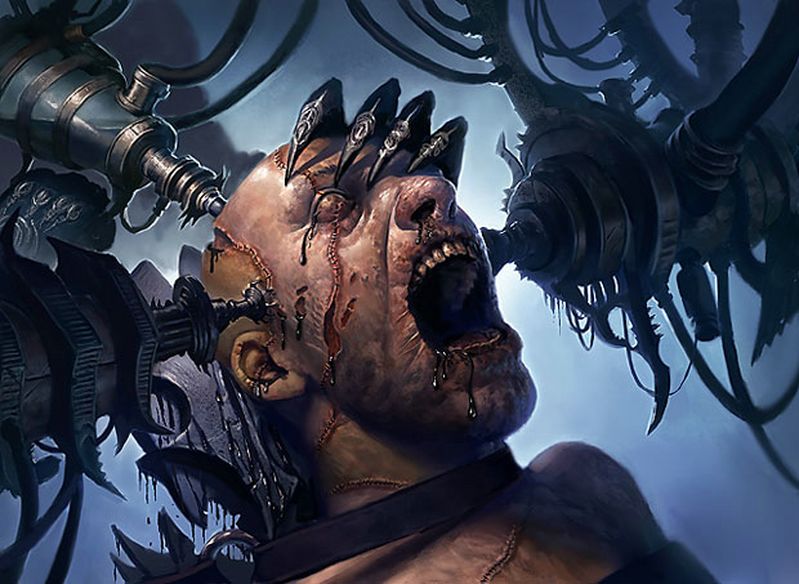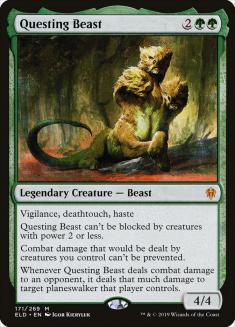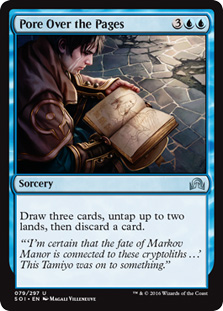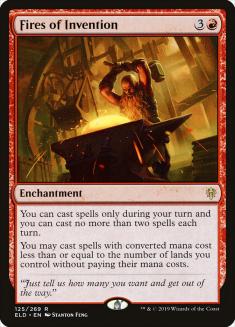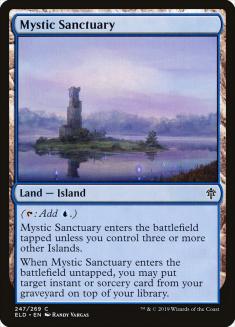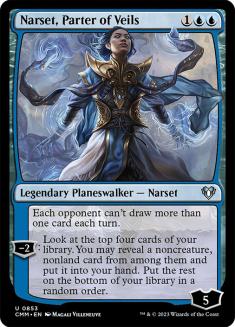My motivation to write this comes largely from Bryan Gottlieb excellent piece on Wednesday and has sparked a bunch of discussion. My response isn’t motivated because the article was “negative” or “critical,” but because Bryan engaged with a variety of topics with a blend of wisdom and humility. Most criticisms that come from people, even community figures or professional players, don’t meet a minimum bar for engagement, but Bryan’s piece was different.
Nothing here is meant to be a “defense” per se, but just an offering of perspective from someone who has done the work for a long time and currently works on Magic. I am a contractor, I don’t speak for Wizards of the Coast (WotC), and this isn’t a hard science, anyway. Patrick Chapin once said something to me along the lines of, “No one really knows what they’re doing here. We just have a bunch of smart people trying to sort it out and a bunch of examples of it being done wrong.” That’s always resonated with me and I’m sure there will be opinions and thoughts in here that some of my colleagues disagree with, which is fine.
As time has gone on, I’ve started to think about designing a massive, evergreen game like Magic as something close to working in a front office for a professional sports team. You’re trying your best to make a bunch of 55/45 bets in spots where you don’t have all the information you need, and where the downside risk can be disastrous in certain spots.
Unlike sports, you can’t just “sit out” certain decisions. If a trade seems too risky and the upside is too thin, you can just move along. Here, the cards need to go to print and be sold. You always have to do something, and if you’re presented with a bunch of 55/45 bets, it’s unavoidable that some of them go wrong. “This card is too good” is a risk, but so is “no one is excited about the new set,” and so “avoid risk” isn’t a meaningful call to action. And much like sports, the people making the calls are excoriated by fans when they go wrong (even if the process was good), and the dozens of smart moves on the margins largely go ignored. Worst of all, it’s very hard to see the counterfactuals. You don’t get to see what the alternate realities look like, so it’s hard to ever know if you were “right” or “wrong” even in spots where the conclusion seems obvious.
I’m not complaining, to be clear. The work is good and fun, and it’s an honor to touch something that so many people care about. Cards I’ve designed are going to print in the next year, and it will be the highlight of my career to see those cards for the first time. I just want to frame the challenge — you’ve got to make a bunch of cards a year for a number of formats and demographics under fairly tight time constraints, massive externalities coming from all directions, and a captured based of millions, some of whom are absolute geniuses when it comes to identifying the “mistakes” and have the financial incentive to discover them. Magic has the most design resources of any game I’ve ever worked on (both in terms of head count and ancillary resources afforded to design), but I don’t know what “adequate” would look like under these circumstances. It might not exist.
The crux of Bryan’s piece centers around what he believes to be four “flawed conclusions” tacitly exposed by Play Design and adjacent “corrections” that would move the needle in the right direction. From the article:
Flawed Conclusion #1
- Increased power level generates player excitement.
Correction #1
- Increased power level generates player excitement now but is trading against future equity.
I don’t know if the first thing is an explicit ideology of Play Design but it seems reasonable enough that we can assume it. In both cases, I would say “it depends.” Plenty of busted Magic sets and designs were not received with much fanfare upon release. Future Sight and New Phyrexia are among the most powerful sets of all time. Future Sight was actually clogged in the channel (meaning, the sealed product was not moving) until people got their heads around just how strong the set was, and the depth of outrageous cards in New Phyrexia wasn’t appreciated initially, either. On an individual card level, Necropotence, Cursed Scroll, and Sphinx’s Revelation were panned during their preview season, only to become defining cards across multiple formats.
This to me suggests that excitement doesn’t have a one-for-one relationship with power. The ability to digest it, understand it, and appreciate it also comes into play, and if people are befuddled by power that is baffling (sets and individual cards that are too hard to process are criminally underrated, even today), this should cut the other way as well (people get excited for things that maybe aren’t as good as they look, but are fun to read or easy to process or something else).
I don’t agree with the conclusion drawn in the correction, either. Oko, Thief of Crowns is a fantastic example of trading against future equity. Not only is it so powerful that you play it at the expense of cards new and old, but it collapses interaction into a very narrow binary, so the new cards you print aren’t likely to change the reality. But as a hypothetical example the other way, how about:
Landlord of Atlantis
1U
Creature — Merfolk
Other Merfolk you control get +1/+1 and Islandwalk.
2/2
This is a “strictly better” version of Lord of Atlantis, a multi-format Constructed player, and not in a way that’s trivial. Merfolk decks get subsidized by lands like Mutavault and Wasteland, and so giving them a lord that’s easier on the mana is meaningful. Maybe this is invalidating Lord of Atlantis, but probably not; these decks are always in the market for more lords. And if this card gave Merfolk enough of a boost that future Merfolk that otherwise would be a bit short show up in decks, that sounds like “growing future equity,” not eating at it.
Further, Merfolk decks play devotion-centric payouts like Master of Waves and Thassa, God of the Sea. If we don’t like the impact of Landlord of Atlantis invalidating previous lords, maybe we make another appealing devotion payout in the next set, so maybe you’d want to play Lord of Atlantis, and maybe some different lands, to get the extra mana symbol. That sounds like growing future equity, too.
Is Questing Beast eating or growing future equity if it encourages cards that deal four damage that are otherwise a little fringe? Is Underworld Breach eating or growing future equity if Pore Over the Pages is in a deck and cards that interact with enchantments at instant speed (normally not a necessary term of engagement) are at a premium? Maybe it’s raw inflation, maybe it’s something else, maybe the context of the surrounding cards matter.
Landlord of Atlantis is a crude, sloppy example of power creep that I hope would not go to print. But I mention it as an example of doing crude, sloppy power creep in a way that’s at least ambiguous to the extent to which previous and future content is invalidated, and with numerous workarounds to “get out from under it” in the cases where it goes wrong. Judicious inflation of creatures around M10 and Zendikar grew the equity, too. By making creatures good enough to play in older formats, cards that otherwise would not have had context (like creature removal) instead got a chance to shine.
Does it count as “inflation” if we started at the ceiling? People have been playing Swords to Plowshares and Lightning Bolt for nearly 30 years; those cards act as very powerful barriers for new cards getting played, and I don’t see them treated with the same vitriol as significantly less problematic but newer barriers. My summary here is — of course it’s complicated, but some powerful cards and power creep come at the expense of past and future designs, and some actually promote a more diverse ecosystem. It’s complicated.
Flawed Conclusion #2
- Secrecy is paramount for generating launch excitement, and beta testing carries too high a risk of information leak.
Correction #2
- Secrecy is paramount for generating launch excitement, but the value of beta testing is worth the risk.
Secrecy is paramount for generating launch excitement, though I’m not equipped to know what “too high a risk” is. Let’s hand-wave that for a second. I really question the efficacy of beta testing in general. The ramp up of information is so daunting, usually requires taking information from the initial team at face value, and remember that we’re here in the first place because we don’t trust that information.
My experience with design hires it that it usually takes about six months for them to not be actively harmful to the process, assuming they have potential. Pro players usually have massive blind spots around play patterns, incentives, and other elements of the game you stop caring about once you’re playing for stakes. That isn’t to say don’t explore it or there won’t be some diamonds in the rough, but I think the yield here is lower on average than other places where resources can be applied.
Flawed Conclusion #3
- Commander is the most popular form of Magic, so designing products specifically for that segment of players makes business and design sense.
Correction #3
- Commander is the most popular form of Magic, so making sure the core products serve these players makes business and design sense.
I don’t see this as an either/or thing. Well-executed Commander products are great, and wise design in “regular” releases that is informed by Commander needs can be great, too. To Bryan’s point about Vizzerdrix and One With Nothing — to me it is less about the rares being powerful than the rares having purpose. I won’t argue the aggregate rare is much better than it was ten or twenty years ago, but I don’t think Isamaru, Hound of Konda should be a rare either, and that card isn’t weak. Part of the reason to make commons and uncommons relatively simple is to make the rares splashy by comparison, and since we know players are awful at evaluating rate, it’s important for them to read a certain way, which the previous examples don’t.
To the other point — I think Commander is more dissimilar to any competitive Constructed format than any two competitive Constructed formats are to one another, and I think the older formats could and would be well-served by products specifically intended to service them. Commander products come with even lower downside risk for their demographic than, say, Modern Horizons (Commander is robust and self-solving from injections of power in ways that Modern is not). Even setting aside that it’s lucrative, it seems like it’s generally been fertile, well-received space, and since the formats are so different I don’t see it intrinsically eating into the design space of Standard releases.
I do think it’s a mistake to make Fires of Invention and Wilderness Reclamation the same mana cost, so similar in functionality, and both super-good in the same Standard format, so no argument there.
Flawed Conclusion #4
- Printing cards that are fun in Standard but damage eternal formats is worth it, and allocating adequate resources to testing eternal formats is not possible.
Correction #4
- Printing cards that are fun in Standard but damage eternal formats might be worth it, but it isn’t something that happens with any regularity and this line of thinking is only leading to broadly flawed cards. While we can’t dedicate adequate resources to testing eternal formats, if we are careful with a small subset of Magic cards, good Standard design will lead to good eternal design.
Bryan mentions Narset, Parter of Veils; Oko, Thief of Crowns; Veil of Summer; Uro, Titan of Nature’s Wrath; Once Upon a Time; and Teferi, Time Raveler as designs that have been highly impactful and harmful to eternal formats. To me, the the sum of all of them besides Oko having most of their power baked into “draw a card” is significantly more damning than the power level of any individually or in totality. I think Narset, Parter of Veils is an unambiguously positive design; its power level scales up almost perfectly with how offensive the play pattern of the opposing player is, but I appreciate people landing differently here.
Mystic Sanctuary gets called out as “what’s the point” when I see this as being done the right way. Sure, the card hasn’t shown up in Standard yet, and maybe it won’t. But it isn’t embarrassing or implausible, and the opportunity cost is low enough that maybe it gets a shot someday. But it is good with fetchlands, and the biggest systemic concern with older formats is them getting too fast, and so maybe you need something like Mystic Sanctuary to subsidize those decks at a low opportunity cost.
Interesting that the same is true of Narset, Teferi, Uro, and even Oko — they are powerful for decks that are looking to play a number of turns, to accrue small advantages, to nickle-and-dime — exactly the type of stuff that usually sucks as formats get more powerful. Yes, the shift in the formats has been dramatic, but is that bad? Why should older formats be nothing but Mishra’s Baubles and Gurmag Anglers? Better still, since all those cards cost three or four, you can’t just play them all, so you have to pick and choose which ones you like best, as opposed to trying to make new cards for older formats by making them cheap, where they just stack on top of one another.
The challenge of making expensive cards good enough to play in older formats is extremely daunting, and I think it is fruitful to try to subsidize decks with some midrange cards that are actually appealing to normal human beings. Maybe some of them are excessive, could still serve the goals while being slightly toned down, and Once Upon a Time is a head-scratcher, but I believe the shift in older formats has been made better by these cards, not worse. It’s one thing to make a Thoughtseize that doesn’t cost life; that’s pointless, harmful inflation. But much like Baneslayer Angel ten years ago, how much inflation is really going on if it’s improving a class of card that doesn’t show up in the first place?
I know I end a lot of sentences in this with a question mark. That can take a leading tone. But I really do want to leave it as an exercise to the reader to think about this stuff if they’d like from a variety of perspectives. It’s okay if you don’t love Constructed right now. That’s the great thing about Magic; even if you aren’t happy with it right now, the promise of a new set making things different looms large.
Thank you for reading, and thanks especially to Bryan Gottlieb for such a thoughtful, humble, passionate piece.

